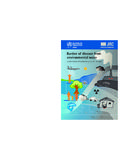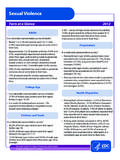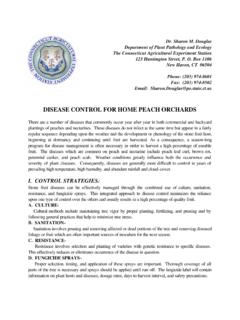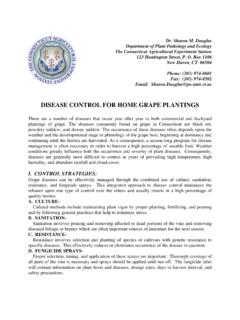Transcription of PREVENTING DISEASE THROUGH HEALTHY …
1 Towards an estimate of the environmental burden of diseasePREVENTING DISEASE THROUGH HEALTHY ENVIRONMENTSHow much DISEASE could be prevented throughbetter management of our environment? Theenvironment influences our health in many ways THROUGH exposures to physical, chemical and biologicalrisk factors, and THROUGH related changes in ourbehaviour in response to those factors. To answer thisquestion, the available scientific evidence wassummarized and more than 100 experts were consultedfor their estimates of how much environmental riskfactors contribute to the DISEASE burden of 85 report summarizes the results globally, by 14regions worldwide, and separately for children. The evidence shows that environmental risk factors playa role in more than 80% of the diseases regularlyreported by the World Health Organization. Globally,nearly one quarter of all deaths and of the total diseaseburden can be attributed to the environment.
2 Inchildren, however, environmental risk factors canaccount for slightly more than one-third of the diseaseburden. These findings have important policyimplications, because the environmental risk factorsthat were studied largely can be modified byestablished, cost-effective interventions. Theinterventions promote equity by benefiting everyone inthe society, while addressing the needs of those most 92 4 159382 2 WHOPREVENTING DISEASE THROUGH HEALTHY ENVIRONMENTS - Towards an estimate of the environmental burden of diseasePREVENTING DISEASE THROUGHHEALTHY ENVIRONMENTST owards an estimate of theenvironmental burden of diseaseA. Pr ss- st n and C. Corval nPrinted in FranceWHO Library Cataloguing-in-Publication DataPr ss- st n, DISEASE THROUGH HEALTHY environments. Towards an estimate of the environmental burden of DISEASE . / Pr ss- st n A, Corval n Environmental monitoring. 2. Cost of illness. 3. Risk factors.
3 I. Corval n, Carlos F. II. World Health 92 4 159382 2(NLM classification: WA ) World Health Organization 2006 All rights reserved. Publications of the World Health Organization can be obtained from WHO Press, World Health Organization, 20 Avenue Appia,1211 Geneva 27, Switzerland (tel: +41 22 791 3264; fax: +41 22 791 4857; email: Requests for permission to reproduceor translate WHO publications whether for sale or for noncommercial distribution should be addressed to WHO Press, at the above address(fax: +41 22 791 4806; email: designations employed and the presentation of the material in this publication do not imply the expression of any opinion whatsoever onthe part of the World Health Organization concerning the legal status of any country, territory, city or area or of its authorities, or concerningthe delimitation of its frontiers or boundaries. Dotted lines on maps represent approximate border lines for which there may not yet be mention of specific companies or of certain manufacturers products does not imply that they are endorsed or recommended by the WorldHealth Organization in preference to others of a similar nature that are not mentioned.))
4 Errors and omissions excepted, the names of proprietaryproducts are distinguished by initial capital reasonable precautions have been taken by the World Health Organization to verify the information contained in this publication. However,the published material is being distributed without warranty of any kind, either express or implied. The responsibility for the interpretation anduse of the material lies with the reader. In no event shall the World Health Organization be liable for damages arising from its named authors alone are responsible for the views expressed in this DISEASE THROUGH HEALTHY environments2 TABLE OF CONTENTSPREFACE6 EXECUTIVE SUMMARY81 INTRODUCTION182 WHAT IS THE ENVIRONMENT IN THE CONTEXT OF HEALTH?203 WHAT IS MEANT BY THE "ATTRIBUTABLE FRACTION" OF A RISK FACTOR?244 METHODS265 ANALYSIS OF ESTIMATES OF THE ENVIRONMENTAL ATTRIBUTABLE FRACTION, BY DISEASE32 Respiratory infections33 Diarrhoea34 Malaria34 Intestinal nematode infections36 Trachoma37 Schistosomiasis37 Chagas disease37 Lymphatic filariasis38 Onchocerciasis38 Leishmaniasis39 Dengue39 Japanese encephalitis39 HIV/AIDS40 Sexually transmitted diseases41 Hepatitis B and hepatitis C41 Tuberculosis42 Perinatal conditions43 Congenital anomalies44 Malnutrition44 Cancers45 Neuropsychiatric disorders46 Cataracts47 Deafness48 Cardiovascular diseases48 Chronic obstructive pulmonary disease49 Asthma49 Musculoskeletal diseases50 Road traffic injuries50 Unintentional poisonings51 Falls52 Fires52 Drownings52 Other unintentional injuries53 Suicide54 Interpersonal violence54 Physical inactivity55 Other diseases566 GLOBAL RESULTS OF THE ANALYSIS587 CONCLUSIONS64 ANNEX 1 WHO Member States.
5 By WHO subregion and mortality stratum72 ANNEX 2 Global statistics produced by the analysis of the environmental DISEASE burden 74 REFERENCES90 ACKNOWLEDGEMENTS102 CREDITS104 PREVENTING DISEASE THROUGH HEALTHY environments4 TABLE OF CONTENTSLIST OF FIGURESFIGURE 1 Definition of the environment21 FIGURE 2 Probability distributions of five expert estimates for the attributable fraction of road traffic injuries30 FIGURE 3 Overlay of individual expert estimates, CRA estimate, and pooled estimate for road traffic injuries in developing countries31 FIGURE 4 Environmental DISEASE burden, by WHO subregion60 FIGURE 5 Diseases with the largest environmental contribution60 FIGURE 6 Environmental DISEASE burden in DALYs per 1000 people,by WHO subregion (2002)61 FIGURE 7 Environmental DISEASE burden in deaths per 100 000 people, by WHO subregion (2002)61 FIGURE 8 Main diseases contributing to the environmental burden of DISEASE , for the total population62 FIGURE 9 Main diseases contributing to the environmental burden of DISEASE among children 0-14 years62 LIST OF TABLESTABLE 1 Environmental risk factors and related diseases included in the CRA27 TABLE environmental fractions for each DISEASE or DISEASE group 75 TABLE values for environmental attributable fractions, by specific environmental risk factor and DISEASE or DISEASE risk 80 TABLE attributable to environmental factors, by DISEASE and mortalitystratum, for WHO regions in 200282 TABLE of DISEASE (in DALYs) attributable to environmental factors, by DISEASE and mortality stratum, for WHO regions in 200288 PREFACE6 PREVENTING DISEASE THROUGH HEALTHY environmentsHOW MUCH DISEASE CAN BE PREVENTED THROUGHHEALTHIER ENVIRONMENTS?
6 His question lies at the heart of our global efforts to address the rootcauses of ill health THROUGH improved preventive health strategies -using the full range of policies, interventions and technologies in ourarsenal of knowledge. Previous World Health Organization studies have examined the aggregatedisease burden attributed to key environmental risks globally andregionally, quantifying the amount of death and DISEASE caused by factorssuch as unsafe drinking-water and sanitation, and indoor and outdoor airpollution. Building from that experience, this present study examines how specificdiseases and injuriesare impacted by environmental risks, and whichregions and populations are most vulnerable to environmentally-mediateddiseases and injuries. This report confirms that approximately one-quarter of the global diseaseburden, and more than one-third of the burden among children, is due tomodifiable environmental factors. The analysis here also goes a stepfurther, and systematically analyzes how different diseases are impacted byenvironmental and by 'how much.
7 ' Heading that list are diarrhoea,lower respiratory infections, various forms of unintentional injuries, andmalaria. This 'environmentally-mediated' DISEASE burden is much higher inthe developing world than in developed countries - although in the case ofcertain non-communicable diseases, such as cardiovascular diseases andcancers, the per capita DISEASE burden is larger in developed bear the highest death toll with more than 4 millionenvironmentally-caused deaths yearly, mostly in developing countries. Theinfant death rate from environmental causes is 12 times higher indeveloping than in developed countries, reflecting the human health gainthat could be achieved by supporting HEALTHY environments. This analysis details the health impacts of environmental risks across morethan 80 diseases and injuries. Findings are particularly relevant to healthcare policymakers and practitioners. Our evolving knowledge aboutenvironment-health interactions can support the design of more effectivepreventive and public health strategies that reduce corresponding risks tohealth.
8 These estimates involved not only a systematic literature review in all ofthe DISEASE categories addressed, but also a survey of more than 100experts worldwide. As such, this analysis represents the result of asystematic process for estimating environmental burden of DISEASE that isT7unprecedented in terms of rigor, transparency and comprehensiveness. It incorporates the best available scientific evidence on population riskfrom environmental hazards currently available. While not an official WHOestimate of environmental burden of DISEASE , as such, it is an importantinput. More immediately, findings can be used to highlight the mostpromising areas for immediate intervention, and also gaps where furtherresearch is needed to establish the linkages and quantify population risk(burden of DISEASE ) for various environmental risk measures can indeed be taken almost immediately to reduce thisenvironmental DISEASE burden. Just a few examples include the promotionof safe household water storage and better hygiene measures, the use ofcleaner fuels and safer, more judicious use and management of toxicsubstances in the home and workplace.
9 At the same time, actions bysectors such as energy, transport, agriculture, and industry are urgentlyrequired, in cooperation with the health sector, to address the rootenvironmental causes of ill health. There is good news in this report, however. These findings underline thefact that environment is a platform for good health that we all share incommon. Acting together on the basis of coordinated health, environment anddevelopment policies, we can strengthen this platform, and make a realdifference in human well-being and quality of life. Coordinated investments can promote more cost-effective developmentstrategies with multiple social and economic co-benefits, in addition toglobal health gains, both immediate and long term. Repositioning thehealth sector to act more effectively on preventive health policies, whileenhancing intersectoral partnerships, is thus critical to addressing theenvironmental causes of DISEASE and injury, meeting the MillenniumDevelopment Goals, and achieving better health for all.
10 Dr. Maria NeiraDirectorPublic Health and EnvironmentWorld Health OrganizationAir pollution exposure/UNEP/Shihua SUMMARYhis global assessment provides quantitative estimates of 'burden ofdisease' from environmental factors across the major categories ofreported diseases and injuries. By focusing on the DISEASE endpoint, and how various kinds of diseases areimpacted by environmental influences, the analysis forges new ground in anunderstanding of interactions between environment and health. The estimates,in effect, reflect how much death, illness and disability could realistically beavoided every year as a result of reduced human exposures to environmentalhazards. Specifically considered here are "modifiable" environmental factors realisticallyamenable to change using available technologies, policies, and preventive andpublic health measures. These environmental factors include physical, chemicaland biological hazards that directly affect health and also increase unhealthybehaviours ( physical inactivity).
















